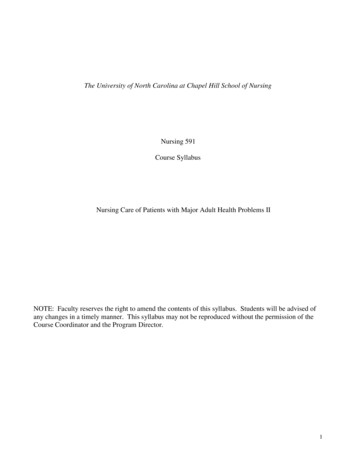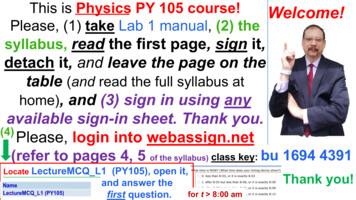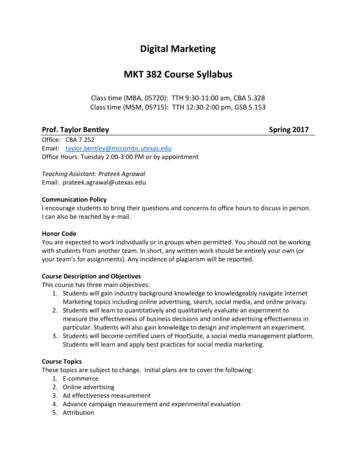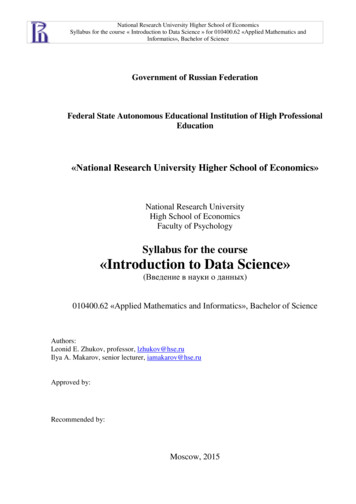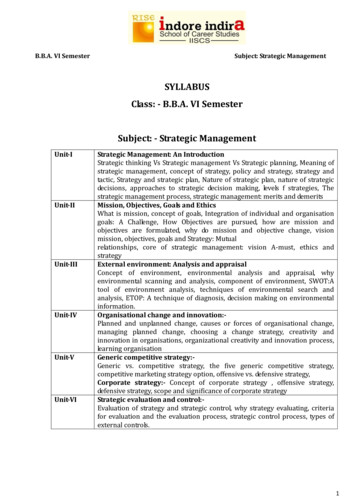
Transcription
B.B.A. VI SemesterSubject: Strategic ManagementSYLLABUSClass: - B.B.A. VI SemesterSubject: - Strategic IStrategic Management: An IntroductionStrategic thinking Vs Strategic management Vs Strategic planning, Meaning ofstrategic management, concept of strategy, policy and strategy, strategy andtactic, Strategy and strategic plan, Nature of strategic plan, nature of strategicdecisions, approaches to strategic decision making, levels f strategies, Thestrategic management process, strategic management: merits and demeritsMission, Objectives, Goals and EthicsWhat is mission, concept of goals, Integration of individual and organisationgoals: A Challenge, How Objectives are pursued, how are mission andobjectives are formulated, why do mission and objective change, visionmission, objectives, goals and Strategy: Mutualrelationships, core of strategic management: vision A-must, ethics andstrategyExternal environment: Analysis and appraisalConcept of environment, environmental analysis and appraisal, whyenvironmental scanning and analysis, component of environment, SWOT:Atool of environment analysis, techniques of environmental search andanalysis, ETOP: A technique of diagnosis, decision making on environmentalinformation.Organisational change and innovation:Planned and unplanned change, causes or forces of organisational change,managing planned change, choosing a change strategy, creativity andinnovation in organisations, organizational creativity and innovation process,learning organisationGeneric competitive strategy:Generic vs. competitive strategy, the five generic competitive strategy,competitive marketing strategy option, offensive vs. defensive strategy,Corporate strategy:- Concept of corporate strategy , offensive strategy,defensive strategy, scope and significance of corporate strategyStrategic evaluation and control:Evaluation of strategy and strategic control, why strategy evaluating, criteriafor evaluation and the evaluation process, strategic control process, types ofexternal controls.1
B.B.A. VI SemesterSubject: Strategic ManagementUNIT 1Strategic Thinking vs. Strategic Management vs. Strategic PlanningIt is generally assumed that there is no difference among the term ‘strategic thinking’, strategic management’and ‘strategic planning’ and all are same in nature and scope. In fact, all these terms are closely inter-relatedbut not have the same meaning and scope. ‘Strategic thinking’ is pre-requisite for strategic management andstrategic planning which involves looking for solutions both inside and outside the organization, and whichfocuses on intent hand takes a holistic or systems view. It is much more than simply having a new idea andcomprises a creative but order sequence of intellectual activities including the generation of completely newideas, followed by the application of rational thinking to the development of those ideas. ‘StrategicManagement’ is any action taken to realize a strategy, in particular to realize the vision which results fromcreative strategic thinking. It is action taken within the framework of the strategy. ‘Strategic planning assumesa further step in the molding of the future in which strategic management, often fragmentary and inchoate, istranslated into highly formal and coherent written plans and actions to realize those plans.Strategic management‘Strategic management is not a box of tricks or a bundle of techniques. It is analytical thinking andcommitment of resources to action.’– Peter DruckerThe primary task of management is to make decisions and take action upon that decision. This taskdetermines the excellence, survival and existence of an enterprise. Simply this process is known as strategicmanagement. The job of strategic management is to make the best use to a firm’s resources in a changingenvironment. To a large extent, the success, failure or stability of a firm depends in strategic management.Today all types of organizations are running in continuous changing situations on the one hand, while variousinternal pressure and environmental pressure have made it imperative for a manager to think and actstrategically. It is related with making long range decision relating to an organization and its environment.Globalization and privatization have also increased the importance of strategic management which stressmanaging the organization’ relationship with its environment as a means to achieve missionaccomplishment. Examples of world famous multinational corporation like IBM, General Motors, Zerox,Mazda are before us who are continue not only in existence but also in a good competitive position for lastthree decades due to the use of strategic management.Meaning of strategic ManagementIn simple words, strategic management is a process of relating the organization with environment throughstrategy formulation and implementation. This emphasis that there is continuous interaction between and itsenvironment and have open system approach. Strategic management is concerned with making decision thatrelate the organization to its environment, setting long-term goals, and allocating resources to achieve thesegoals. It is always concerned with the long-term welfare of the organization and what is the organizationmust adopt for changing needs. Anderson has explained three major components of strategic management.The first component involves analysis of the external environment. Modern managers are highly concernedwith rate of change in what is referred to as task environment or that portion of the environment with whichthe managers should interact on a regular basis. The second component is strategy. Strategy is the statementof objectives and plans for the entire organization. Strategy determines the purpose of the organization andkeeps concerned with such issues as organizational strengths and weaknesses, competitors’ analysis, valueof top managers, and what strategies the organization has applied in the past. Organizational design, thethird component of strategic management, matches the strategic goals and purpose of the organization withthe people who will do the work and the way they are organized to do it.Anderson opines that strategic management is usually considered the domain of top management only, butthe concept of strategic management are increasingly being applied to lower management levels such asdivisions, departments and even small work groups.In operational management, goals are usually validated through extensive past experience and that arereduced to specific sub-goals for functional units. Issues are abstract and deferrable and may be unfamiliar instrategic management while in operational management, issues are of immediate, concrete and familiar innature. The following diagram shows the relationship between strategic management and operating and2
B.B.A. VI SemesterSubject: Strategic Managementadministrative management.Strategic Management DevelopsOrganizational MissionOrganizational objectivesOrganizational StrategiesOperating ManagementImplementprogramsandprojectsMeasure and evaluates resultsAdministrative Management DevelopsObjectives and strategies fordivisions or departmentsPrograms, projects and budgets fordivisions or departmentsThe Concept of StrategyThe concept of strategy is ancient. Originally, the word ‘strategy’ is derived from the Greek word ‘Strategeia’which means ‘the art of the general’. It has been associated with first determining the position of a military,business or political organization in relation to its environment and then using the organization’s resourcesto reach its goals. The Greeks knew that strategy was more than fighting battles. Effective generals have todetermine the right lines of supply, decide when to fight and when not to fight and manage the army’srelationship with citizens, politicians and diplomats. Effective general not only had to plan but had to act aswell. These early military roots of strategy have, of course, expanded into political and business arena aincreased competition and environmental change have forced organizations to plan more carefully for thefuture. A key aim of both business and military strategy is to gain competitive advantage. In both, theorganizations they try to use their own strengths to exploit competitors’ weaknesses. The element of surpriseprovides great competitive advantages in both military and business strategy. According to David, ‘afundamental difference between military and business strategy is that business strategy is formulated,implemented and evaluated with an assumption of ‘competition’, whereas military strategy is based on anassumption of ‘conflict’.Policy and StrategyIt seems to be a great confusion about ‘policy’ and ‘strategy’ in management literature. Some people are ofthe opinion that both these words are same and may be used in place of one another, while others feelsignificant difference between them. Simply, ‘policies’ may be defined as general guides to action that outlinethe framework within which objectives are establishes and strategies are selected and implemented.Brian Quinn, “policies are rules or guidelines that express the limits within which action should occur.”‘Strategy’ may be defined in business to describe how an organization intends to achieve its objectives andmission. Most organizations have several options for accomplishing their objectives and mission. Strategy isconcerned with deciding which option is going to be used. So far differences between these are concerned, itis clearly known. Strategy is concerned with matching external opportunities with corporate resources atacceptable level of profit and risk. Basically it involves the following three types of actions – (a) determinationof long-term goals and objectives, (b) determination of courses of action to achieve those goals, and (c)allocation of resources for carrying out actions. Policy determines the nature of the firm’s involvement withits environment. This is likely to concern functional activities as well as the corporate whole. Thus, we havepolicies for –PositioningFinancingOperational controlGrowth merchandiseGeographical coveragePricingStore size and locationAdvertising and promotion3
B.B.A. VI SemesterSubject: Strategic ManagementAnother difference between policy and strategy is that, policy is concerned with guidelines to thinking andaction of those who make decisions while strategy is concerned with the direction in which human andphysical resources are deployed and applied in order to maximize the chances of achieving organizationalobjectives.In short, policy and strategy are related terms in a wide sense. Where strategy relate an organization with itsenvironment. Policy determines the nature of the firm’s involvement with its environment. Both areimportant at different levels of an organization so as to achieve its objectives.Strategy and TacticsTactics is a means through which pre-decided plans are executed. It is related to efficient utilization of variousorganizational resources committed through strategy. Tactics is developed at lower levels of management andit follows strategy. Tactics is formulated from a functional point of view. Some people are of the opinion thatstrategy and tactics have same meaning and can be used in place of each other. But both these terms arequite different. Strategy is a comprehensive of wide term which is directly related with organizationaldecisions while tactics is only a part of strategy by which pre-determined plans are executed.Tactics is usually short-term decision that involves a lower commitment of resources than strategic decisions.Strategy and Strategic PlanStrategic plan is a course of action which is designed to meet long-term objectives of an organization. Strategydeals with the choice and direction that the organization desires to-follow. It is a course of action throughwhich an organization relates itself with environment so as to achieve its objectives. These definitions clearlyshow that strategic plan is a wider term while strategy is only a part of it. Strategic plan is related withmission and future direction, short and long-term performance targets and strategy of an organization.Strategy, on the other hand, is a set of decision-making rules for the guidance of organizational behavior. Astrategic plan consists of an organization’s mission and future direction, short-term and long-termperformance targets, internal action approach and strategy to be used in achieving the targeted businessresults. Many large companies, who are committed to review their strategy regularly, usually prepare writtendocument describing industry’s economics, key success factors and drivers of change along with thecompany’s strategic plan for dealing their external and internal environment. Such companies circulate thestrategic plan to all managers and selected employees, along with some strategic initiatives. Organizationalobjectives are the part of the strategic plan most often spelled out explicitly and communicated to managersand employees.Nature of Strategic DecisionsStrategic decisions are those which are taken during the current time period but whose primary effect is feltduring some future period. Such decisions affected organizational structures, objectives, facilities andfinances. These decisions are mostly complex and non-repetitive in nature and have fundamental effects onthe organization. So these are taken comparatively at higher level of management after careful analysis andevaluation of various alternatives.Strategic decisions have the following characteristics –1. They involve significant commitments of the organization’s resources.2. They involve uncertainty. There are always several uncontrollable (environment) factors involved instrategic planning and unlike most other decisions, strategic decisions look further into future.3. They are made by senior management.4. They have important implications for the future of the entire organization.4
B.B.A. VI SemesterSubject: Strategic Management5. Most importantly, strategic decisions fundamentally change the character of business and are‘irreversible’. This means that strategic decisions involve a commitment of resources that cannot beregained, at least in short-term.6. Strategic decisions are different from operating decisions which relates to day-to-day activities orcurrent operations.Approaches to Strategic Decision-MakingDecision-making is a process of selection and the aim is to select the best alternative. It also involves theevaluation of available alternatives because only through this evaluation can one know the best alternative. Itis a mental process because the final selection is made after thoughtful consideration. Therefore, threeaspects of human behavior are involved in decision-making –a. Cognition, those activities of the mind associated with knowledgeb. Conation, the action of the mind implied by such words as willing, desire and aversion, andc. Affection, the aspects of the mind identified with emotion, feeling, mood and temperament.William F. Glueck opines that ‘a decision is made by a decision-maker in a decision environment. Thisenvironment is strongly influenced by the beliefs and values of the decision-maker. Various theories havebeen suggested about how decisions are made. The main theories are as follows –1. Rational Theory of Decision-making – This theory assumes that the decision-maker is a unique actorwhose behavior is intelligent and rational. Whatever decisions he makes, he makes them with fullawareness of all available feasible alternatives.One major weakness of this theory is that the decision-maker is affected by the whole environment,so he cannot be a unique actor. Besides, he cannot consider all alternatives or know all theconsequences due to various limitations (like incomplete information, cost, time etc.)2. Behavioral Theory of Decision-making – This theory assumes that various factors like limitedknowledge, individual needs and drives, values, pressures etc., are limitations in the choice of adecision-maker. Therefore, he does not seek to maximize outcome, but choose the first satisfactoryalternative he finds which fits his values.3. The Political Theory – This theory assumes that decision-making is a process. A decision-maker canmake good decision only when he considers a variety of pressures from other people affected by hisdecision.In sum, an organization affects or is affected by the various stakeholders. Decisions are made when theseveral people, involved in the process, agree that they have found a common solution. The decision-makerhas to use his mind, emotion, rationality, intuition, along with mutual adjustment and negotiation, in makingdecision.Now the question arises where do strategic decisions take place? As said earlier that strategy is a decisionmaking rules that guides and relates an organization with its environment. It is a continuous process. A firmoperates in a dynamic environment and is bound to make decision or change its strategy regularly accordingto chat environmental changes and pressures for managerial and business success. In the process ofcontemplating the need for change, the proposal is likely to be considered in relation to the gap between theexpected outcomes and desires outcomes.Levels of StrategyManagement of every organization follows some kind of process and can be viewed in the context ofstrategic management concept. Different business organizations, having some similar features, may havesome differences according to size that relate to their strategic behavior. There are also different levels orunits within a business entity, and some of those units can have strategic different from other.In brief, strategies are operated at different levels in a organization. Corporate level strategy, business levelstrategy, functional level strategy and operating strategy. A brief discussion of these strategies is as follows –5
B.B.A. VI SemesterSubject: Strategic Management1. Corporate level Strategy – Corporate level strategy is formulated by top management to oversee theinterest and operations of organization made up of more than one line of business. It occupies thehighest level of strategic decision-making and cover actions dealing with the objectives of firm,acquisition and allocation of resources, and coordination of strategies of various units. the majorquestions at this level are as follows –i.What kinds of businesses should the company be engaged in?ii.What are the goals and expectations for each business?iii.How should resources be allocated to reach these goals?2. Business level strategy – Business level strategy is concerned with managing the interests andoperations of a particular line of business. It refers to the managerial game plan for a single business.It is mirrored in the pattern of approaches and moves crafted by management to produce successfulperformance in one specific line of business. It deals with such questions as –i.How will the business compete does its markets?ii.What products or services should it offer?iii.Which customer does it seek to serve?iv.How will resources be distributes within the business?Basically, business level strategy attempts to determine what approach to its market and businessshould take and how it should conduct itself, given its resources and the conditions of the market.3. Functional level strategy – It involves decision-making at the operational level with respect tospecific functional areas – production, marketing, personnel, finance etc. In fact, strategy creates aframework for managers in each function to carry out business unit strategies and corporatestrategies. Decisions at this level are often describes as ‘tactical divisions.’4. Operating level strategy – It is concerned with the regulation of day-to-day activities of departmentaland supervisory managers.The following diagram shows the various hierarchy level of strategy more clearly –6
B.B.A. VI SemesterSubject: Strategic ManagementHierarchy Level of StrategyBusiness Level StrategyFunctional Level StrategyOperating StrategyThe Strategic Management ProcessAs discussed earlier that strategic management is a process of relating the organizational with itsenvironment by suitable course of action involving strategy formulation and ensuring that the strategy hasbeen implemented effectively.1. The strategic management process begins with strategic intent (mission an vision) of a corporation. Inthis step, the vision, mission and objectives are established. Strategic vision defines what business thecompany is presently in and conveys the essence of ‘who we are’, ‘what we do’ and ‘where we are now’.Mission is enduring feature of an organization. It states the image which the organization wishes toproject and provides guidelines to decision-makers on continuous basis. A strategically missionstatement incorporates three elements:a. Customer needs,b. Customer groupsc. The company’s activities, technologies and competence.Setting objectives converts the strategic vision into specific performance targets. Objectives represent amanagerial commitment to achieve achieving specific outcomes and results. Establishment of strategic intent(vision, mission and objective), makes clear what an organization stands for. It may be defined as a ‘big, hairyaudacious god’ and takes a long time to achieve.2. The second step of strategic management process is environment analysis which helps in finding out theopportunities and threats operating in the environment and strengths and weaknesses of anorganization. Since an organization is a social system, it operates within the environment which consistsof many factors (political, cultural, legal, social etc.) In this interaction process, the organization has torelate itself with the environment. Environmental analysis also includes organizational analysis, whichbrings strength and weakness of an organization. It also helps in identifying the relevant environmentalfactors taken for detailed analysis.Strategic Intent(Vision, Mission and Objectives)Formulation of StrategiesEnvironmental appraisalOrganizational appraisal7
B.B.A. VI SemesterSubject: Strategic Management3. The third important step in strategic management process is related with strategic decision (choice of astrategy). Since the particular strategy attempts to affect the organizational operation in some predetermined manner, the choice process systematically considerers how each alternative affects thevarious critical factors of the organization.The fourth step of strategic management process is related with implementation of a strategy. Here thestrategic plan is out into action through project implementation, process implementation, resourcesallocation, structural implementation, behavior implementation and functional and operationalimplementation. In other words, various activities like organization structure, effective leadership,allocation of resources etc., are designed for effective implementation of strategy in this step.4. Evaluation and control is the last of the strategic management process in which strategy is reviewed andresult of strategy implementation are monitored. In fact, it is ongoing process in which implementation ofstrategy is monitored continuously and necessary action is taken whenever required.Strategic Management: Merits and DemeritsThe strategic management has been getting wide acceptance in business world since 1980. In the beginning,it has been accepted by executive of developed nations, but today most of the multinationals and largecorporations have adopted it. Now executives and managers assume that strategic management is the onlyapproach on which success or failure of a corporation depends to a large extent. Globalization, liberalizationand privatization have made strategic management more popular and important. Some of the importantbenefits of strategic management are as follows:8
B.B.A. VI SemesterSubject: Strategic Management1. Strategic management allows a firm/s top executive to anticipate change and provides direction andcontrol for the enterprise.2. It allows the firm to innovate in time to take advantage of new opportunities in the environment andreduce the risk because the future is anticipated.3. It helps ensure full exploitation of opportunities.4. It provides clear objective and direction for employees.5. This is conducive to greater harmony and goal congruence.6. If focuses on problems of the whole enterprise, not just functional problems in marketing or financeareas.7. It enables management to improve the chances of making decisions which will stand the test of time,and revising the strategy on the basic of monitoring the progress of various functions.8. It also helps in building strategic knowledge of management and develops the attitudes necessary tobe a successful generalist.9. The conditions of most business are changing so fast. Besides, these changes have increaseddramatically in last three decades. Strategic management is only the way to anticipate future problemsand opportunities. In fact, growth, existence and survival of an organization depend on strategicmanagement to a large extent in fat changing situations. It is only the way by which managementmay be able to make the best uses of a firm’s resources in a changing environment.Research study also proves that business which perform formal strategic planning and management have ahigher probability of success than those which do not because of the following reasons –1. It is only the way to systematize the most important of business decisions.2. It helps educate managers to become better decision-makers.3. It helps in improving corporate communication and conditions of individual projects.4. It serves as a road map of the corporation.5. It lays down the growth objectives of the firm and also provides the strategies needed for achievingthem.6. It serves as a hedge against uncertainty arising from environmental turbulence.7. It ensures that the firm remains a prepared organization8. It helps the firm understanding trends in advance and provides the benefit of a lead time for takingcrucial decisions and actions.9. It helps avoid haphazard response to environment.10. It provides the best possible fit between the firm and the external environment.11. It ensures that the firm’s businesses, products and markets are chosen wisely.12. It ensures best utilization of the firm’s resources among the product-market opportunities.13. It helps in building competitive advantages and core competencies.14. It draws from both intuition and logic.Although strategic management helps managers to anticipated changing conditions and opportunities, it canbe a solution to all business and managerial problems because of the following reasons –1. Environmental conditions are changing so fast, so that mangers cannot do any long range planning.2. Objectives, set by managers, are usually vague and general.3. Usually mangers reasons for success of an organization, strategic management may be one of them.9
B.B.A. VI SemesterSubject: Strategic Management10
B.B.A. VI SemesterSubject: Strategic ManagementUNIT 2Mission1) The mission carries the grand design of the firm which communicates what it wants to be. It clarifiesthe very purposes of the corporation. It also represents the corporation’s guiding principles. Thecompany mission is defined as the fundamental, unique purpose that sets a business apart from otherfirms of its type and identifies the scope of its operations in product and market terms’. The missionis thus the reference point and guiding spirit for the growth plan of a firm. It brings the corporatepurpose or the long-term objective of the firm into focus.2) The mission can be seen as a link between performing some social functions and more specifictargets of the organization. Once it is defined carefully, it provides a statement of outsiders andinsiders to know what the company stands for a legitimating of its goals.3) Following table shows some of the sample examples of mission, developed by world famemultinationals:OrganizationAT & T4) MissionAT & T is in communications, not telephones. Ours is the business ofinformation handling, not knowledge business.IBMWe respect the human being and we want to give more good servicesto the clients than any other firm in the world. Our belief is that anorganization should do its work with this belief that it can be achievedin superior fashion.MGMMGM provides entertainment, not just movie.TechnoTenneco is in energy, not just oil and gasJohnson and JohnsonWe believe our first responsibility is to the doctors, nurses andpatients, to mothers and all other who use our product and service.The above examples explain that the corporate mission is an expression of the growth ambition ofthe firm. It is the firm’s future visualized which provides a dramatics picture of what the firm wantsto become.Mainly the following qualities should be included in the mission of an organization –Feasible – A mission’s aim should always be high but it should not be improper and impractical. Itshould be proper and practical.Precise – A mission statement should be precise. It should not be longer and meaningless.Clear – A mission should be clear sufficiently on which action can be taken. It should not be extremelyimproper only in the view of publicity on advertisement purpose.Motivating – Mission word should be motivating for the member of an organization and for society.They should feel proud to see them.Distinctive – Organization’s mission should be distinctive from other firms and organizations, so theorganization can get its distinctive recognition.Indicate major component of strategy – A mission word should indicate components of strategy,along with organizational aim.How objectives are to be accomplished – With the above points, it should be indicated in t
strategic management while in operational management, issues are of immediate, concrete and familiar in nature. The following diagram shows the relationship between strategic management and operating and . B.B.A. VI Semester Subject: Strategic Management


